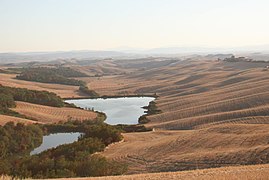Crete Senesi
Crete Senesi are literally the "clays of Siena": the distinctive grey colouration of the soil gives the landscape an appearance often described as lunar. This characteristic clay, known as mattaione, represents the sediments of the Pliocene sea which covered the area between 2.5 and 4.5 million years ago. The landscape is characterized by barren and gently undulating hills, solitary oaks and cypresses, isolated farms at the top of the heights, stretches of wood and ponds of rainwater (commonly referred as fontoni, literally "big springs") in the valleys. Badlands and biancane are typical conformations of the land.

Perhaps the most notable edifice of this area is the Abbey of Monte Oliveto Maggiore, located 10 km south of Asciano.
The region is known for its production of white truffles, and hosts a festival and a museum dedicated to the rare fungus (genus Tuber).
Gallery
-
Cereal crops are cultivated with the aid of irrigation
-
Crete Senesi in Asciano area
-
Panorama with fontoni
-
Badlands of Accona desert
-
Sunset in Saltafabbro, Asciano
References
- ^ "Crete Senesi". www.cretesenesi.com. Retrieved 26 March 2020.
External links
43°12′N 11°34′E / 43.200°N 11.567°E




